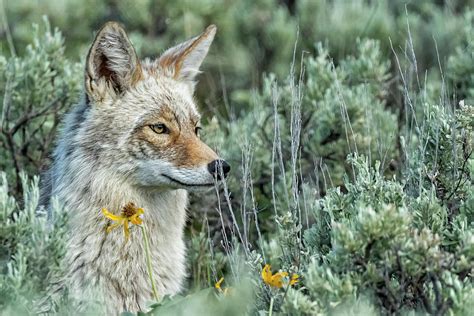
A stunning photograph of a coyote in Yellowstone National Park has captivated viewers, but it’s not just the animal’s beauty that has drawn attention; a subtle detail reveals the presence of a less conspicuous companion. The image, shared widely on social media, showcases the coyote’s thick winter coat and piercing gaze, while keen observers have spotted a badger lurking nearby, highlighting the unique interspecies relationship.
Yellowstone National Park, renowned for its geothermal features and diverse wildlife, has once again become a focal point of interest, this time due to a captivating photograph showcasing the intricate relationships within its ecosystem. The image, initially shared across various social media platforms, depicts a coyote in its full winter splendor, its fur thick and providing insulation against the harsh Yellowstone climate. However, it’s not just the coyote’s striking appearance that has captured the attention of nature enthusiasts and wildlife experts alike. Hidden in the background, almost blending into the landscape, is a badger, a detail that speaks volumes about the complex and often symbiotic relationships that exist in the wild.
“It’s not unusual to see a coyote and badger hunting together,” Yellowstone National Park officials stated, confirming the significance of the sighting. This partnership, though seemingly odd to the casual observer, is a well-documented phenomenon in Yellowstone and other areas where these species coexist. The coyote, with its speed and agility, is adept at chasing down prey, while the badger, a powerful digger, excels at excavating animals from their burrows. By working together, these two predators increase their chances of a successful hunt, demonstrating a remarkable example of interspecies cooperation.
The photograph, taken by an amateur wildlife enthusiast, has been praised for its composition and clarity. The coyote, positioned prominently in the foreground, appears alert and focused, its eyes conveying a sense of both wildness and intelligence. The badger, though partially obscured, is still clearly visible, its presence adding depth and context to the scene. The image serves as a reminder of the hidden dramas that unfold daily in Yellowstone, far from the view of most park visitors.
The relationship between coyotes and badgers is a classic example of mutualism, where both species benefit from the interaction. Coyotes are opportunistic predators, feeding on a variety of small mammals, birds, and insects. Badgers, on the other hand, are primarily fossorial, meaning they spend much of their time underground. Their diet consists mainly of ground squirrels, prairie dogs, and other burrowing animals. When hunting together, coyotes and badgers complement each other’s skills. The coyote can chase prey above ground, while the badger can dig into burrows, preventing the prey from escaping.
Studies have shown that coyotes and badgers are more successful at hunting when they work together. In one study, researchers found that coyotes hunting with badgers caught significantly more ground squirrels than coyotes hunting alone. Similarly, badgers hunting with coyotes were more likely to capture prey that had escaped above ground. This cooperative hunting strategy not only increases the chances of success for both species but also reduces the amount of energy they expend searching for food.
The presence of both a coyote and a badger in the same frame also highlights the overall health and biodiversity of Yellowstone National Park. The park, which spans over 2.2 million acres, is home to a wide array of wildlife, including grizzly bears, wolves, elk, bison, and pronghorn. The park’s diverse habitats, ranging from grasslands and forests to rivers and lakes, support a complex web of life. The fact that coyotes and badgers are thriving in Yellowstone is a testament to the park’s effective conservation efforts.
However, the relationship between coyotes and badgers is not always harmonious. While they often cooperate in hunting, they can also compete for resources. In some cases, coyotes have been known to steal prey from badgers, or vice versa. Additionally, coyotes may occasionally prey on young badgers. Despite these occasional conflicts, the overall relationship between the two species is generally positive.
The recent photograph of the coyote and badger in Yellowstone has sparked renewed interest in the park’s wildlife and the importance of conservation. Many people have expressed their appreciation for the image, praising its beauty and its ability to capture a moment of natural history. The photograph has also served as a reminder of the need to protect Yellowstone and other wild places from the threats of development, climate change, and habitat loss.
Yellowstone National Park faces numerous challenges in the 21st century. Climate change is altering the park’s ecosystems, leading to changes in vegetation, water availability, and wildlife distribution. Invasive species are also a major concern, as they can outcompete native plants and animals. Additionally, increasing tourism puts pressure on the park’s resources and infrastructure.
Despite these challenges, Yellowstone National Park remains a vital refuge for wildlife and a source of inspiration for people around the world. The park’s dedicated staff work tirelessly to protect its natural resources and provide visitors with opportunities to experience the wonders of the natural world. The photograph of the coyote and badger serves as a powerful reminder of the beauty and complexity of Yellowstone and the importance of preserving it for future generations.
The popularity of the photograph also speaks to the growing interest in wildlife photography and nature documentaries. As more people become aware of the threats facing the planet’s biodiversity, they are increasingly drawn to images and stories that showcase the beauty and fragility of the natural world. Wildlife photographers play an important role in raising awareness about conservation issues and inspiring people to take action.
The image has triggered discussions about the ethical considerations involved in wildlife photography. Some critics argue that wildlife photographers can sometimes disturb animals or damage their habitats in pursuit of the perfect shot. However, most wildlife photographers adhere to a strict code of ethics, which includes minimizing their impact on the environment and respecting the animals they are photographing.
The coyote and badger partnership is not unique to Yellowstone. Similar relationships have been observed in other parts of North America and in other parts of the world with different species. For example, in Africa, honey badgers and honeyguides have a similar cooperative relationship. The honeyguide leads the honey badger to beehives, and the honey badger breaks open the hive, allowing both animals to feed on the honey and larvae.
These interspecies relationships highlight the interconnectedness of ecosystems and the importance of protecting biodiversity. When one species declines, it can have cascading effects on other species in the ecosystem. Conservation efforts must therefore focus on protecting entire ecosystems, rather than just individual species.
The photograph of the Yellowstone coyote and badger is a reminder that there is still much to learn about the natural world. Scientists are constantly discovering new species and new interactions between species. By studying these interactions, we can gain a better understanding of how ecosystems function and how to protect them.
The image also underscores the importance of citizen science. Amateur naturalists and photographers can make valuable contributions to our understanding of the natural world by sharing their observations and photographs. Citizen science projects can help scientists collect data over a large geographic area and monitor changes in wildlife populations.
In conclusion, the photograph of the Yellowstone coyote and badger is more than just a pretty picture. It is a window into the complex and fascinating world of interspecies relationships. It is a reminder of the beauty and fragility of nature. And it is a call to action to protect our planet’s biodiversity. The image encapsulates the wild beauty and intricate ecological relationships thriving within Yellowstone National Park, reminding viewers of the interconnectedness of nature and the importance of conservation efforts.
The image serves as a vital reminder of the importance of preserving these natural ecosystems. The collaboration between these species is a testament to the intricate relationships that exist in the wild. The photo is not just a beautiful snapshot, but a story of survival, cooperation, and the delicate balance of nature. The ongoing health of the park depends on maintaining its biodiversity, and this image represents a success story in that regard. The sighting of these two animals together, healthy and thriving, sends a positive message about Yellowstone’s ecological integrity.
The impact of this photograph extends beyond its aesthetic appeal; it also serves as an educational tool. By showcasing the cooperative hunting strategies of coyotes and badgers, the image helps to inform the public about the complexities of wildlife behavior and the importance of preserving natural habitats. It’s a compelling example of how seemingly disparate species can form beneficial relationships that contribute to the overall health of an ecosystem.
Moreover, this photograph prompts a broader discussion about the role of national parks in conservation. Yellowstone, as one of the oldest and most iconic national parks in the world, serves as a crucial refuge for numerous species, including coyotes and badgers. The park’s management practices, which prioritize habitat preservation and wildlife protection, are essential for maintaining the biodiversity of the region. This image reinforces the importance of continued support for national parks and their conservation missions.
The ongoing protection of Yellowstone’s ecosystems is also vital for the broader ecological health of the Greater Yellowstone Ecosystem, a vast area that encompasses the park and surrounding lands. This ecosystem is home to a wide range of species, including grizzly bears, wolves, elk, and bison. The interconnectedness of these species means that the health of Yellowstone has far-reaching implications for the entire region.
The story behind the photograph also underscores the importance of responsible wildlife photography. While capturing stunning images of wildlife can be a powerful way to raise awareness about conservation issues, it is crucial to do so in a way that minimizes disturbance to animals and their habitats. Wildlife photographers should adhere to ethical guidelines that prioritize the well-being of their subjects and avoid actions that could cause harm or stress.
The continued popularity of this photograph also reflects a growing public interest in nature and wildlife. As more people become aware of the environmental challenges facing the planet, they are increasingly drawn to images and stories that celebrate the beauty and resilience of the natural world. This heightened awareness can translate into greater support for conservation efforts and a stronger commitment to protecting the planet’s biodiversity.
This image of the coyote and badger is a microcosm of the larger challenges and opportunities facing conservation today. It highlights the importance of understanding ecological relationships, preserving natural habitats, and promoting responsible stewardship of the environment. By sharing this image and its story, we can inspire others to appreciate the wonders of nature and to take action to protect it for future generations. The story of these two animals is a testament to the enduring power of nature and the importance of preserving its delicate balance.
The photograph’s virality also raises an important point about the role of social media in conservation efforts. By sharing images and stories of wildlife and nature, social media platforms can help to reach a wider audience and raise awareness about conservation issues. However, it is also important to ensure that the information shared on social media is accurate and reliable, and that it promotes responsible behavior in the wild. The ethical considerations regarding posting locations of potentially sensitive animal habitats should also be taken into consideration.
Furthermore, the image opens avenues for educational initiatives, particularly for younger audiences. The story of the coyote and the badger could be integrated into school curricula to teach children about wildlife ecology, interspecies relationships, and the importance of conservation. Such educational efforts can help to foster a new generation of environmental stewards who are committed to protecting the planet’s biodiversity.
The photograph can also serve as a catalyst for further research on coyote-badger interactions. While much is known about the cooperative hunting strategies of these species, there are still many unanswered questions about their behavior and ecology. Additional research could shed light on the factors that influence their interactions, the benefits they derive from their partnership, and the challenges they face in a changing environment.
In summary, the viral photograph of the Yellowstone coyote and badger is more than just a visually appealing image; it is a powerful symbol of the interconnectedness of nature, the importance of conservation, and the role of national parks in protecting biodiversity. By sharing this image and its story, we can inspire others to appreciate the wonders of the natural world and to take action to protect it for future generations. The image serves as a potent reminder that every species, no matter how seemingly insignificant, plays a vital role in the intricate web of life.
This incident also brings attention to the adaptive capabilities of wildlife. The coyote and badger’s alliance indicates their resourcefulness and ability to adjust to environmental conditions. These partnerships evolve from ecological necessities and display a high level of intelligence and adaptation within these species. The cooperation between them underscores the fact that animal behavior is often more complex and nuanced than we generally perceive. The combined hunting strategy is an example of a learned behavior passed down through generations or adopted through observation and interaction within their ecosystem.
The image and its related discussions also highlight the significance of protected areas like Yellowstone in preserving biodiversity. National parks offer habitats where such interspecies relationships can thrive, free from many of the pressures of human encroachment and development. The preservation of these areas ensures that future generations will have the opportunity to witness such natural phenomena. Moreover, it reinforces the need for continuous conservation efforts, including habitat restoration, invasive species management, and climate change mitigation, to sustain these critical ecosystems.
This instance brings forth the question of potential threats that could disrupt such symbiotic relationships. Habitat fragmentation, due to human development and resource extraction, poses a significant threat to wildlife. As habitats shrink and become isolated, it becomes more difficult for animals like coyotes and badgers to find suitable territories and establish cooperative relationships. Climate change also presents a major challenge, as it can alter ecosystems and disrupt the availability of resources. Changes in temperature and precipitation patterns can affect the distribution and abundance of prey species, which can in turn impact the ability of coyotes and badgers to hunt effectively.
The viral photograph has also ignited discussions about the value of non-intrusive observation and documentation of wildlife. Remote cameras, drones, and other technologies are increasingly being used to study wildlife without disturbing their natural behavior. These tools offer valuable insights into the lives of animals and can help scientists and conservationists to better understand their needs and challenges. The ethical use of these technologies is crucial to ensure that wildlife are not harmed or harassed in the process of being studied.
The image acts as a catalyst for promoting responsible tourism. It underscores the importance of respecting wildlife and their habitats when visiting national parks and other natural areas. Visitors should maintain a safe distance from animals, avoid feeding them, and follow all park regulations. Responsible tourism practices can help to minimize the impact of human activities on wildlife and ensure that these areas remain pristine for future generations.
In conclusion, the photograph of the Yellowstone coyote and badger serves as a multi-faceted reminder of the intricate connections within nature. It emphasizes the importance of conservation, responsible tourism, ethical wildlife observation, and continued research. This single image encapsulates numerous lessons about the need to protect our planet’s biodiversity and ensure the survival of species and their habitats for the generations to come. The captivating collaboration of these two animals serves as a beacon of hope and a call to action for all who care about the future of our planet.
Frequently Asked Questions (FAQ)
1. What is the significance of seeing a coyote and badger together in Yellowstone National Park?
The sighting of a coyote and badger together is significant because it illustrates a unique interspecies relationship where both animals benefit. Coyotes are skilled at chasing prey above ground, while badgers excel at digging into burrows. By hunting together, they increase their chances of capturing prey, showcasing a cooperative hunting strategy known as mutualism. “It’s not unusual to see a coyote and badger hunting together,” according to Yellowstone National Park officials, highlighting the well-documented nature of this partnership within the park’s ecosystem.
2. How do coyotes and badgers benefit from their cooperative hunting strategy?
Coyotes and badgers benefit in several ways. Coyotes can utilize the badger’s digging abilities to flush out prey from underground burrows, increasing their hunting success. Badgers, in turn, benefit from the coyote’s speed and agility in chasing down prey above ground that may have escaped their burrows. Studies have shown that both species are more successful when hunting together compared to hunting alone, conserving energy and increasing their overall food intake.
3. What factors threaten the relationship between coyotes and badgers in Yellowstone National Park?
Several factors can threaten this relationship. Habitat fragmentation due to human development can reduce available territories and disrupt their ability to find suitable hunting grounds. Climate change can alter ecosystems, affecting the distribution and abundance of prey species, thereby impacting their ability to hunt effectively. Competition for resources and occasional conflicts, such as coyotes stealing prey from badgers, can also strain their relationship, although the overall interaction is generally positive.
4. How does the viral photograph of the coyote and badger contribute to conservation efforts?
The viral photograph raises awareness about the beauty and complexity of wildlife interactions in Yellowstone National Park. It serves as an educational tool, informing the public about the cooperative hunting strategies of these species and the importance of preserving natural habitats. It also highlights the role of national parks in providing refuge for wildlife and maintaining biodiversity. The image inspires public interest in nature and wildlife, potentially translating into greater support for conservation efforts and a stronger commitment to protecting the planet’s biodiversity.
5. What ethical considerations are involved in wildlife photography, as highlighted by the coyote and badger image?
The photograph raises ethical considerations about minimizing disturbance to animals and their habitats. Wildlife photographers should adhere to strict ethical guidelines that prioritize the well-being of their subjects and avoid actions that could cause harm or stress. This includes maintaining a safe distance from animals, respecting their natural behavior, and avoiding the use of flash photography or other intrusive techniques. Responsible wildlife photography contributes to conservation efforts by raising awareness without negatively impacting the animals or their environment.
6. Does the collaborative relationship between coyotes and badgers exist elsewhere in the world?
Yes, while the coyote-badger partnership is well-known in North America, similar collaborative relationships exist between different species in other parts of the world. A classic example is the relationship between honey badgers and honeyguides in Africa. The honeyguide bird leads the honey badger to beehives, and the badger breaks open the hive, allowing both animals to feed on the honey and larvae. These interspecies collaborations highlight the interconnectedness of ecosystems and the diverse ways that animals have adapted to enhance their survival.
7. What role does Yellowstone National Park play in protecting wildlife and fostering interspecies relationships like the one between coyotes and badgers?
Yellowstone National Park serves as a critical refuge for wildlife, providing a vast and relatively undisturbed habitat where species can thrive and interact naturally. The park’s management practices prioritize habitat preservation and wildlife protection, including measures to control invasive species, mitigate human-wildlife conflict, and monitor wildlife populations. Yellowstone’s commitment to conservation helps to ensure that interspecies relationships like the coyote-badger partnership can continue to flourish, contributing to the overall health and biodiversity of the Greater Yellowstone Ecosystem.
8. How can individuals contribute to the conservation of species and ecosystems like those found in Yellowstone?
Individuals can contribute to conservation efforts in various ways. This includes supporting national parks and conservation organizations through donations and volunteer work, practicing responsible tourism when visiting natural areas, reducing their carbon footprint to mitigate climate change, and advocating for policies that protect wildlife and habitats. Educating themselves and others about conservation issues and making sustainable choices in their daily lives can also make a significant difference in preserving biodiversity and ensuring the long-term health of our planet.
9. What kind of research is being conducted to better understand the interaction between coyotes and badgers?
Researchers are using a variety of methods to study the interaction between coyotes and badgers, including direct observation, GPS tracking, and camera trapping. These studies aim to understand the factors that influence their cooperative hunting behavior, the benefits they derive from their partnership, and the challenges they face in a changing environment. Researchers are also investigating the genetic relationships between different coyote and badger populations to understand how their interactions may vary across different geographic regions.
10. How can the story of the Yellowstone coyote and badger be used to educate children about wildlife and conservation?
The story of the Yellowstone coyote and badger provides an engaging and accessible way to teach children about wildlife ecology, interspecies relationships, and the importance of conservation. Educators can use the photograph and its related information to create lesson plans that explore the concept of mutualism, the role of national parks in protecting wildlife, and the ways that humans can contribute to conservation efforts. Interactive activities, such as creating wildlife dioramas or conducting mock research projects, can further enhance children’s learning and inspire them to become environmental stewards.









